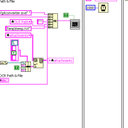C5aR1 promotes acute pyelonephritis induced by uropathogenic E. coli.
Palavras-chave
Resumo
C5a receptor 1 (C5aR1) is a G protein-coupled receptor for C5a and also an N-linked glycosylated protein. In addition to myeloid cells, C5aR1 is expressed on epithelial cells. In this study, we examined the role of C5aR1 in bacterial adhesion/colonization of renal tubular epithelium and addressed the underlying mechanisms of this role. We show that acute kidney infection was significantly reduced in mice with genetic deletion or through pharmacologic inhibition of C5aR1 following bladder inoculation with uropathogenic E. coli (UPEC). This was associated with reduced expression of terminal α-mannosyl residues (Man; a ligand for type 1 fimbriae of E. coli) on the luminal surface of renal tubular epithelium and reduction of early UPEC colonization in these mice. Confocal microscopy demonstrated that UPEC bind to Man on the luminal surface of renal tubular epithelium. In vitro analyses showed that C5a stimulation enhances Man expression in renal tubular epithelial cells and subsequent bacterial adhesion, which, at least in part, is dependent on TNF-α driven by C5aR1-mediated intracellular signaling. Our findings demonstrate a previously unknown pathogenic role for C5aR1 in acute pyelonephritis, proposing a potentially novel mechanism by which C5a/C5aR1 signaling mediates upregulation of carbohydrate ligands on renal tubules to facilitate UPEC adhesion.





